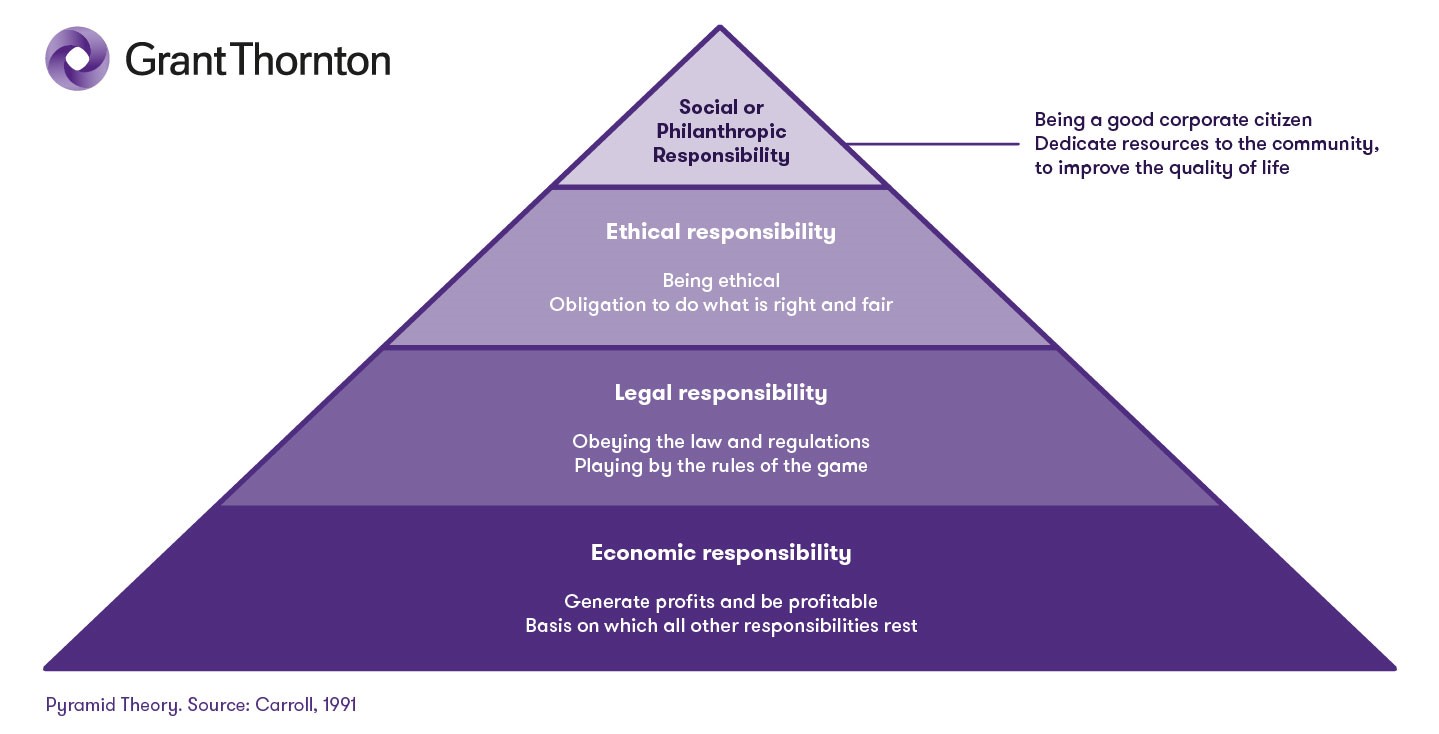-
Compliance
Assistance in the design, implementation and monitoring of Compliance programs within the framework of local and international regulations (FCPA, Corporate Criminal Responsibility Law), including course delivery.
-
Sustainability
Learn how our sustainability services can help you go beyond and build a strong reputation, attract committed investors and generate long-term sustainable financial results.
-
Forensic
The services offer includes expert advice in litigation resolution and the development of procedures in legal/digital forensics and cybersecurity.
-
Human Capital solutions
Grant Thornton's Human Capital division has a team of professionals determined to accompany individuals and organizations throughout the relationship between the employee and the organization.
-
Organizational restructuring
Advice on operational restructuring to companies in difficulty, their creditors or other interested parties.
-
Services to the Government and the Public Sector
Financial audit projects and special technical and concurrent reviews of programs of national and subnational governments financed by International Credit Organizations. Special projects for government entities, public and mixed companies.
-
Valuation Services
We provide stock, business, asset, and liability valuations in support of negotiations, account structuring, and tax opportunities.
-
Transaction Advisory Services
The service offer includes financial due Diligence, operations services, business and strategic intelligence, ratings, advice on mergers and acquisitions, capital markets and debt advice.
-
Academy - Empowered by Grant Thornton Argentina & Perú
Academy is an e-learning platform that emerged as a joint initiative of Grant Thornton Argentina and Grant Thornton Perú. It is designed so that everyone can acquire new skills in accounting, auditing, taxes, technology and business through access to multiple courses and certifications.
-
External audit
We offer services of external audit of financial statements, assurance reports, agreed-upon procedures reports and certifications, due-diligence and take-over of companies.
-
Audit methodology and technology
At Grant Thornton we use a single audit methodology across our global network. We apply it through LEAP, an integrated software audit tool. Get to know it now.
-
Professional standards and training
Our IFRS advisors can help you navigate the complexity of the standards so you can spend your time and effort on your business.
-
Prevention of money laundering and financing of terrorism
At Grant Thornton we provide advice to our clients in the development of an Asset Laundering and Terrorist Financing Prevention strategy that allows them to prevent risks in a comprehensive manner.
-
Tax outsourcing
Taxes have a significant impact on business decisions. At Grant Thornton, we respond quickly and design tailored solutions to ensure organizations are not adversely affected.
-
Payroll
We have the experience and the know-how to perform payroll for various industries, including those in which trade unions and workers' organisations are active.
-
Accounting, administration and finance services
Effective accounting and financial advisory are necessary for the success of an innovative and forward-thinking organization. We provide our knowledge and experience so you can stay focused on your business's core activities.
-
Start-up of companies
The early stages of a business are key to its success. Therefore, it's important to have experts who manage and administer business resources. Learn about our solutions to help you build your company.
-
Financial statements audit
We offer services of external audit of financial statements; assurance reports, agreed procedures and certifications; due-diligence and take-over of companies.
-
FIU Independent External Reviewer - AML/CFT
We participate in the implementation of the requirements of the FIU in leading companies and our services ensure an orderly framework, optimizing the investment.
-
Internal audit
An internal audit helps identify gaps, deficiencies, and potential for inherent risk in all facets of the organization.
-
Legal audit
The monitoring of the legal area is usually a complex and difficult task for organizations, which however cannot be neglected.
-
Creation and acquisition of Financial Entities
We have the knowledge and experience in activities related to the acquisition and creation of financial entities, both locally and internationally.
-
Responsible for regulatory compliance
At Grant Thornton we offer the service of acting as "Responsible for Regulatory Compliance and Internal Control" for companies that requested registration as Settlement and Clearing Agent and Trading Agent.
-
IT Internal Audit
IT has been, and will increasingly be, a key factor for success and operational efficiency in all industries. Innovations such as the cloud and virtualization, and new threats around data security, have reinforced the importance and increased the risks associated with the use of technology for our clients.
-
Cybersecurity
As sophisticated digital manipulations become more prevalent, organizations must strengthen their defences and effectively protect themselves from threats and recognize those that are not. Organizations must act quickly to strengthen trust and resilience. A combination of enhanced security capabilities, robust controls, and employee education and awareness is critical.
-
ITGC Controls
Information Technology General Controls (ITGC) are a set of policies that ensure the effective implementation of control systems throughout an organization. ITGC audits help verify that these general controls are implemented and functioning correctly, so that risk is appropriately managed.
-
Global Mobility Services
Sending someone abroad involves liabilities and obligations. We offer interesting solutions to minimize the tax burden for both parties.
-
Direct Tax
We provide clear and practical solutions that meet your specific business needs, in the most tax-efficient way possible.
-
Indirect Tax
Grant Thornton's tax teams take a rigorous approach to help you meeting your tax obligations, whatever challenges you may face along the way.
-
International taxes – Transaction support
We offer our international experience in the field and make available the resources to plan and adequately comply with regulatory frameworks.
-
Services to private clients
Wherever you are in the world, our tax specialists can help you with your interests and investments abroad.
-
Clean energy and technology
Growing demand, development of new ways of energy and a need for a sustainable future: we support our clients in these changes to be one step beyond their competitors.
-
Mining
Our flexible, partner-led teams are dynamic and focused on development. We take time to understand the details of the client’s business and offer unique solutions.
-
Oil and gas
Our Oil & Gas teams have the deep knowledge, wide experience and vision needed to offer our clients practical solutions adapted to their businesses.
-
Banking
Grant Thornton offers meaningful and accurate solutions for operational and transactional issues, litigation and administrative disputes in banking.
-
Private capital
We gather international teams of experts in corporate finance, restructuring and recovery, tax and insurance services to deliver customized solutions from initial investment, through development stages until the end of each project.
-
Fintech
We work to take advantage of all opportunities and manage industry risks, allowing our clients to always be one step beyond their competitors.
-
Asset management
We have specialized teams in more than 140 markets delivering solutions regarding insurance, taxes and advisory to global, international, regional, local asset managers.
-
Insurance
Thanks to our specialized team we offer accurate solutions for operational and transactional matters, litigations and administrative conflicts.

In 1953, American economist Howard R. Bowen first discussed the concept of Corporate Social Responsibility (CSR) in his book "Social Responsibilities of the Businessmen". In it, he questions companies' responsibility to give back to society.
He defined CSR as the set of policies, values, and practices that a company carries out to contribute to the economic, social, and environmental sustainability of the community in which it is located and operates.
This ethical vision of business, not only includes the company's direct impact on society and the environment, but also implies the company's responsibility to contribute to improve the quality of life of the local community in which it operates. This means, in the lives of its customers, suppliers and collaborators.
In the 1970s, CSR began to consolidate in the United States thanks to the concept of "social contract" between the company and society declared by the Committee for Economic Development in 1971. This so called “contract” is based on the idea that the company is allowed to operate with “public consent” of the groups who participate in its activities and live near the company’s operations. Therefore, companies have the obligation to constructively address the needs of society.
In the 1990s, the emeritus professor at the University of Georgia, Archie B. Carroll, developed the “Pyramid Theory” in which he proposed the four social commitments that companies must assume: economic, legal, ethical and philanthropic.

Responsible business conduct (RBC) is another term -introduced by the OECD- with which organizations name the actions they carry out with the aim of having a positive impact on society and the environment. RBC principles and standards set out an expectation that all businesses –regardless of their size, legal status, ownership structure or sector– avoid and address negative consequences of their operations, while contributing to sustainable development where they operate. Both CSR and RBC are voluntary and demonstrate the commitment to the environment, but the main difference is that CSR only includes companies and RBC extends to all organizations.
What does 'Sustainability' means?
In Spanish there are two terms to refer to sustainability: sustentabilidad and sostenibilidad. The Royal Spanish Academy (RAE) defines sustentabilidad as "that can be sustained or defended with reasons", and in turn, to sustain means "to preserve something in its being or state". On the other hand, sostenibilidad is described as "that it can be sustained for a long time without depleting resources or causing serious damage to the environment”.
For this reason, we can define "sustentable" as something which is maintained or preserved by itself -if it is treated properly-; while something “sostenible” implies the existence of processes that help to create a better social environment, more respectful of the planet.
While in English, according to the Cambridge Dictionary, there is just one word to define something that causes “no or little damage to the environment” and that is “possible to sustain (to cause or allow something to continue for a period of time / to keep alive)”: sustainable. Sustainability means “the quality of causing little or no damage to the environment and therefore, is able to continue for a long time”.
Sustainable development must be understood as a process that seeks to find a balance between the environment and the exploitation of natural resources, avoiding altering their conservation and the state in which they are found, protecting natural systems and people's quality of life. It focuses on the rational use of resources. Reusing and recycling objects and materials are closely related to this concept, as well as the implementation of clean energy and technologies.
In 1987, the United Nations’ World Commission on Environment and Development (UN-WCED) defined sustainable development as "meeting the needs of the present generation without compromising the ability of future generations to meet their own needs" and based it on three pillars: economic development, social development and environmental protection. Sustainable development seeks socioeconomic progress considering social, economic, political and cultural change in pursuit of protecting the environment and the quality of life, health, education and culture of all people.
The goal of sustainability is to eradicate poverty, protect the planet and ensure prosperity for all. This is summarized in the 17 Sustainable Development Goals (SDGs) of UN’s 2030 Agenda.
Corporate Social Responsibility, Responsible Business Conduct and Environmental, Social and Corporate Governance (ESG) are all approaches to sustainable development.
The arrival of ESG
 "Society's demands for sustainable operations have led to the need to establish specific management standards. The need arises to demonstrate, in fact, these achievements accomplished by social actors. Thus, the incorporation of measurable indicators and ratios is currently considered to become part of the information each entity publishes regularly”, explains Alejandro Chiappe, Lead Partner of Advisory and main spokesperson for Sustainability and ESG in Grant Thornton Argentina.
"Society's demands for sustainable operations have led to the need to establish specific management standards. The need arises to demonstrate, in fact, these achievements accomplished by social actors. Thus, the incorporation of measurable indicators and ratios is currently considered to become part of the information each entity publishes regularly”, explains Alejandro Chiappe, Lead Partner of Advisory and main spokesperson for Sustainability and ESG in Grant Thornton Argentina.
As a result of this, the environmental, social and governance criteria (ESG) began to resonate since it provides specific standards in terms of business sustainability that CSR did not provide. However, it was not until 2004 that the ESG concept was officially mentioned in a joint report between the UN and financial institutions. This report, called “Who cares wins”, laid the foundation for integrating ESG with investment strategies.
In 2006, the United Nations launched the Principles for Responsible Investment (PRI), committing to three different areas: responsible investors, sustainable markets and a thriving world for all. Its objective was to fulfil the mission of building "a sustainable global financial system that rewards its users in financial terms and that benefits both the environment and society." 63 investment firms agreed to incorporate these PRI criteria into their financial assessments:
- We will incorporate ESG issues into investment analysis and decision-making processes
- We will be active owners and incorporate ESG issues into our ownership policies and practices.
- We will seek appropriate disclosure on ESG issues by the entities in which we invest
- We will promote acceptance and implementation of the Principles within the investment industry
- We will work together to enhance our effectiveness in implementing the Principles
- We will report on our activities and progress towards implementing the Principles
"The application of ESG policies and their demonstration also have economic and financial impacts, opening the door to access funds in capital markets aimed at financing these initiatives with highly competitive costs," adds Chiappe.
Similarities between CSR and ESG
Both sustainability approaches, CSR and ESG, prioritize the concern for the environment and the society in which the company operates. They ensure respect for people, their community, ethical values and the environment. They express these values integrated into the management of the company, regardless of the market or sector.
A company can implement both approaches considering them complementary since both collaborate with the management of the organization's impact in its community.
Differences between CSR and ESG
In 2001, the European Union defined CSR in its Green paper: Promoting a European framework for Corporate Social Responsibility as a concept whereby “companies integrate social and environmental concerns in their business operations and in their interaction with their stakeholders on a voluntary basis”. Corporate social responsibility has strong philanthropic and ethical support and is more focused on voluntary actions that go beyond the requirements of the law.
The ESG, for its part, arose in the investment community by allowing the investment risk to be highlighted based on a matrix of environmental, social and governance factors. The ESG framework helps identify risk-adjusted returns and highlights the relevance for capital opportunities.
ESG-based sustainability reporting allows for quantitative data to be presented, as the approach involves measurable goals. While those based on CSR present qualitative information on the social impact and serve to externally communicate the objectives and achievements regarding sustainable development.
Sustainability in companies
 “Integrating ESG elements into business practices has become critical nowadays. Companies that adopt a responsible approach and generate a positive impact on their environment have a greater chance of building a solid reputation, attracting committed investors and generating sustainable financial results in the long term”, says Patricia Terraza, Senior Manager of Advisory and spokesperson for Sustainability and ESG in Grant Thornton Argentina.
“Integrating ESG elements into business practices has become critical nowadays. Companies that adopt a responsible approach and generate a positive impact on their environment have a greater chance of building a solid reputation, attracting committed investors and generating sustainable financial results in the long term”, says Patricia Terraza, Senior Manager of Advisory and spokesperson for Sustainability and ESG in Grant Thornton Argentina.

There are many ways to carry out sustainable actions in companies. From donations to organizations in the social sector, to the renovation of work plants to obtain net zero CO2 emissions.
To cite some examples, we can mention how in recent decades, it has become more visible how audio-visual content production companies invest money in philanthropic projects related to environmental initiatives and opt for sustainable work processes when producing a series or film. They also connect with the community where they are going to film, working with NGOs and presenting a social approach of diversity and inclusion in the productions to achieve the visibility of minorities. From an ESG approach, the same companies may aim to reduce greenhouse gas emissions during the productions of series and films and offset their remaining net carbon footprint by capturing it.
In the energy production market, examples can also be mentioned. The Oil & Gas industry in the 1980s generated some of the biggest oil spills that have ever occurred. These incidents led to legislative changes, such as the US Oil Pollution Act. Starting in 2000, adhering to the ESG approach, companies in this sector began to make large investments in technology to reduce greenhouse gas emissions, monitor local fauna in productive ecosystems, and improve their impact on the environment. Currently, these organizations have strong diversity and inclusion policies and programs to coordinate with local leaders and members of the communities where they operate. This is since, to continue their operations, they had to implement actions that inspire social validation, and community alliances in each of the regions in which they operate.
Sustainability at Grant Thornton
At Grant Thornton we also have a commitment to sustainability. As a Global Firm we have a Global Transparency Report. In each country, the firms prepare their own Sustainability Reports. These documents demonstrate our commitment to our collaborators, our clients and our community.
We are aligned with the UN SDGs and our actions are focused on promoting practices that have a positive economic, environmental and social impact in the supply chains of our customers and suppliers.
 “We face great challenges in the Argentine market and in the global context. For this reason, we must prioritize the optimization of processes to achieve more sustainable models of production and generation of resources. Aligned with the values of our network, we promote diversity, inclusion and gender parity policies. The diversity of our teams allows us to have a different perspective that make a difference in the experience we provide to our clients. Our intention is to continue contributing from our corporate role to the 2030 Agenda and the ESG guidelines of Grant Thornton International", Fernando Fucci, Managing Partner of Grant Thornton Argentina.
“We face great challenges in the Argentine market and in the global context. For this reason, we must prioritize the optimization of processes to achieve more sustainable models of production and generation of resources. Aligned with the values of our network, we promote diversity, inclusion and gender parity policies. The diversity of our teams allows us to have a different perspective that make a difference in the experience we provide to our clients. Our intention is to continue contributing from our corporate role to the 2030 Agenda and the ESG guidelines of Grant Thornton International", Fernando Fucci, Managing Partner of Grant Thornton Argentina.